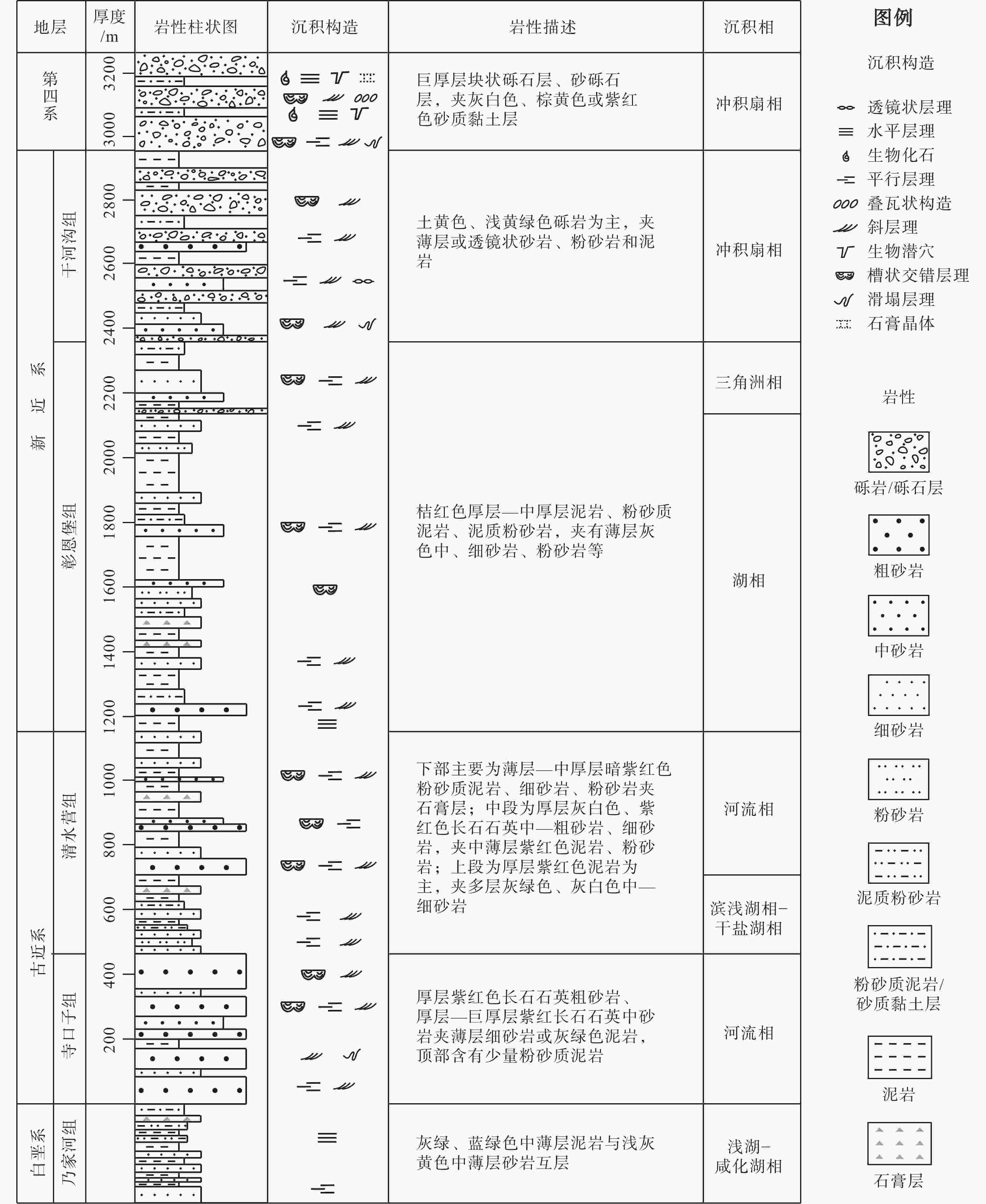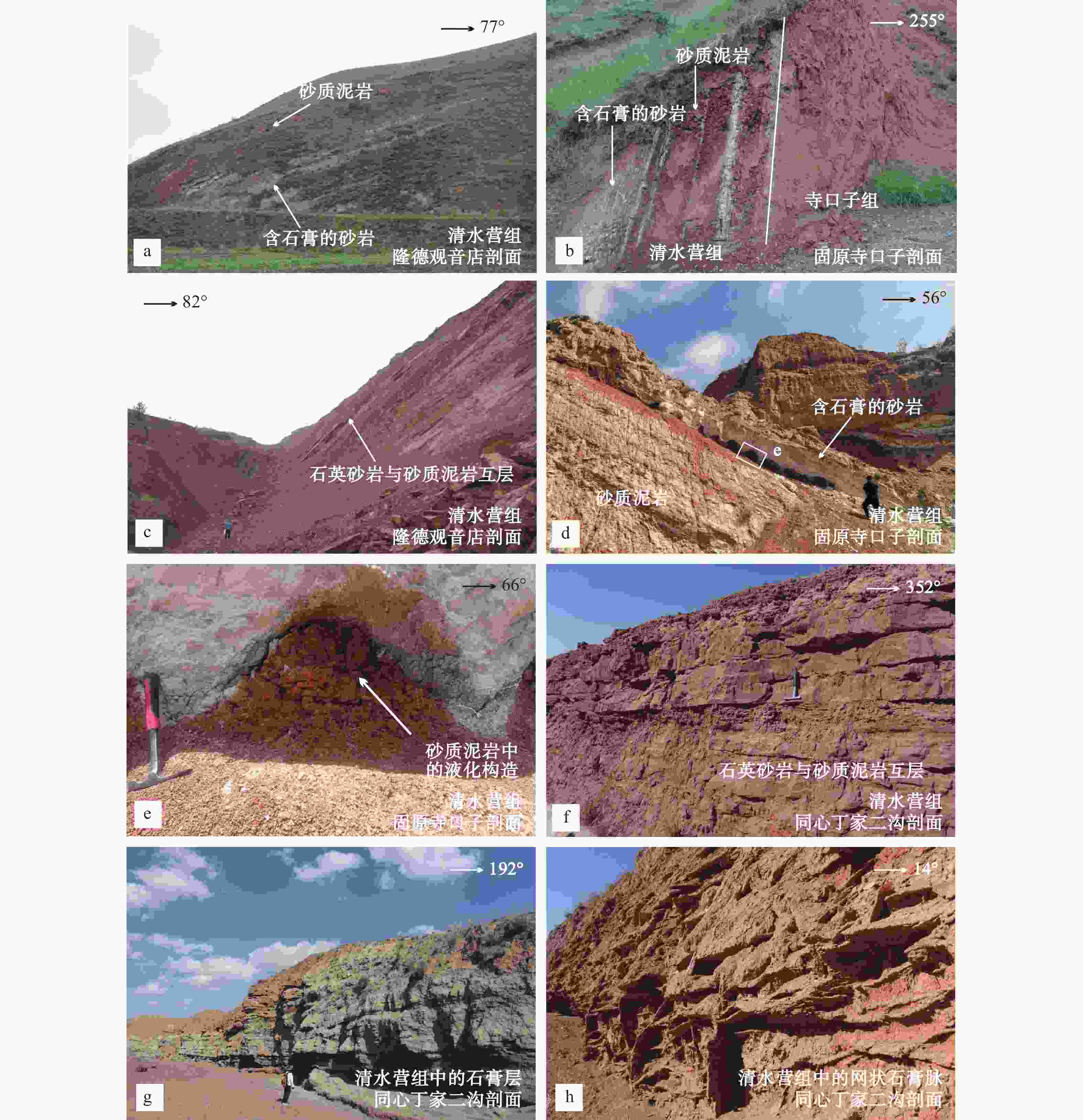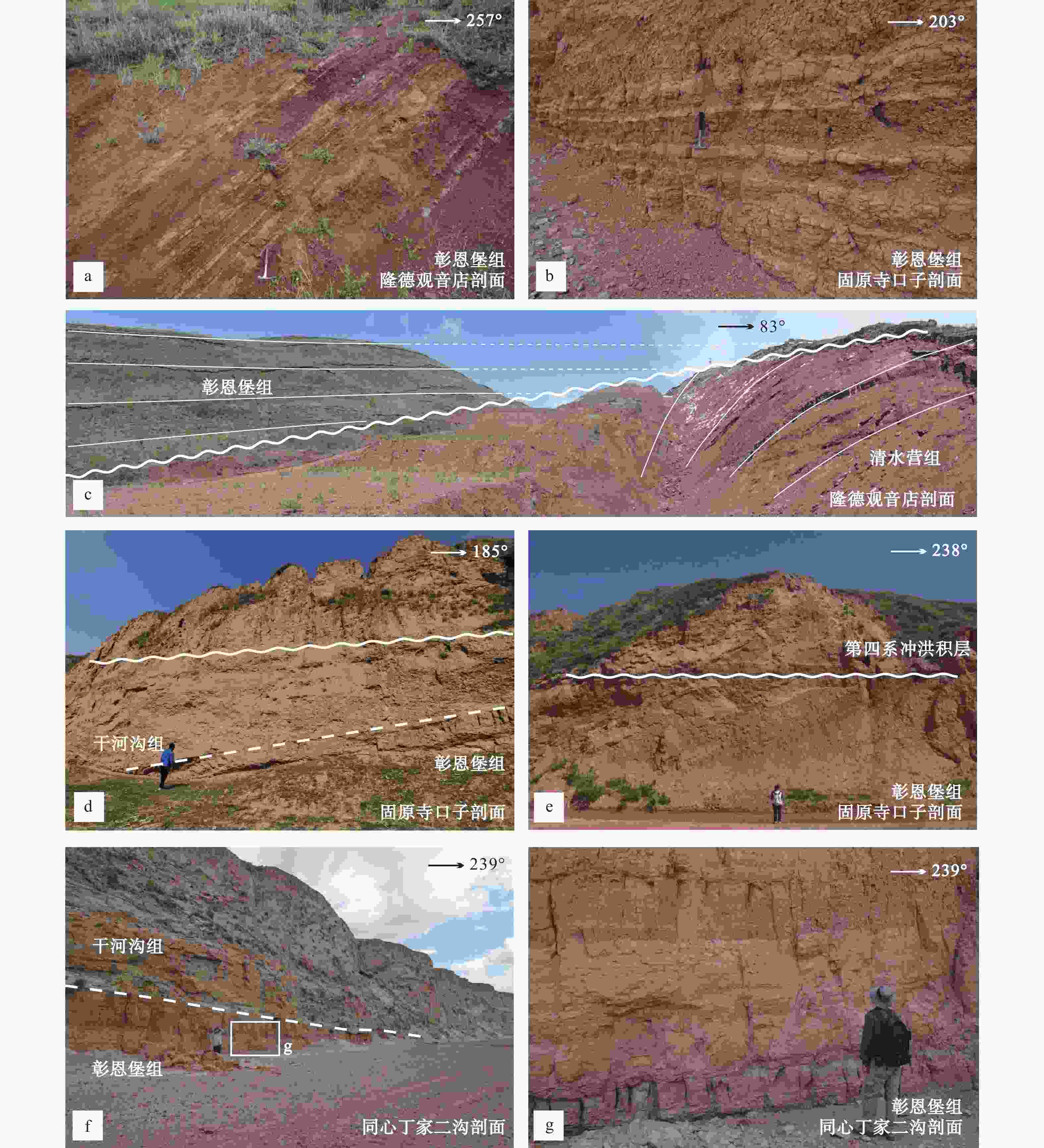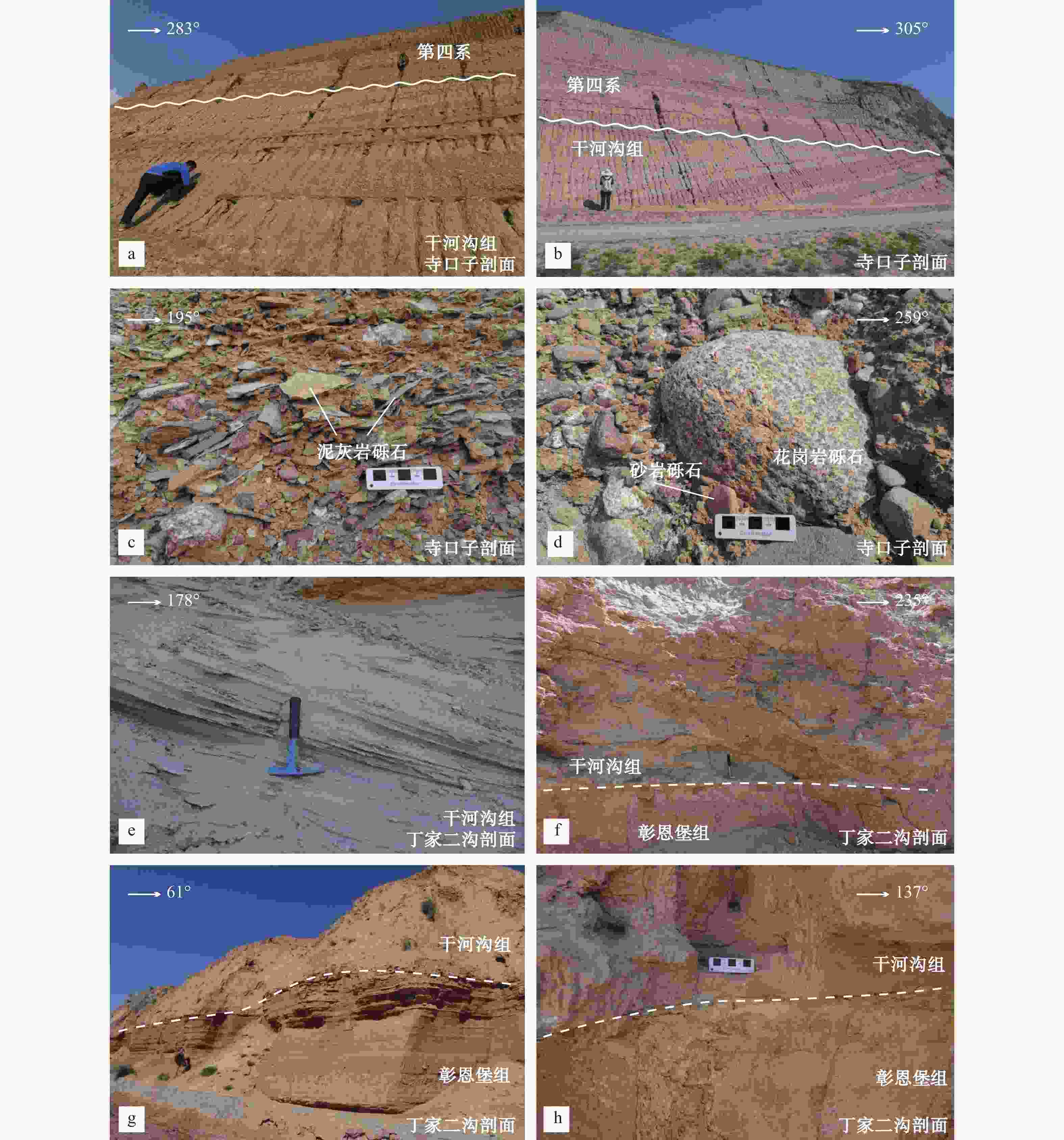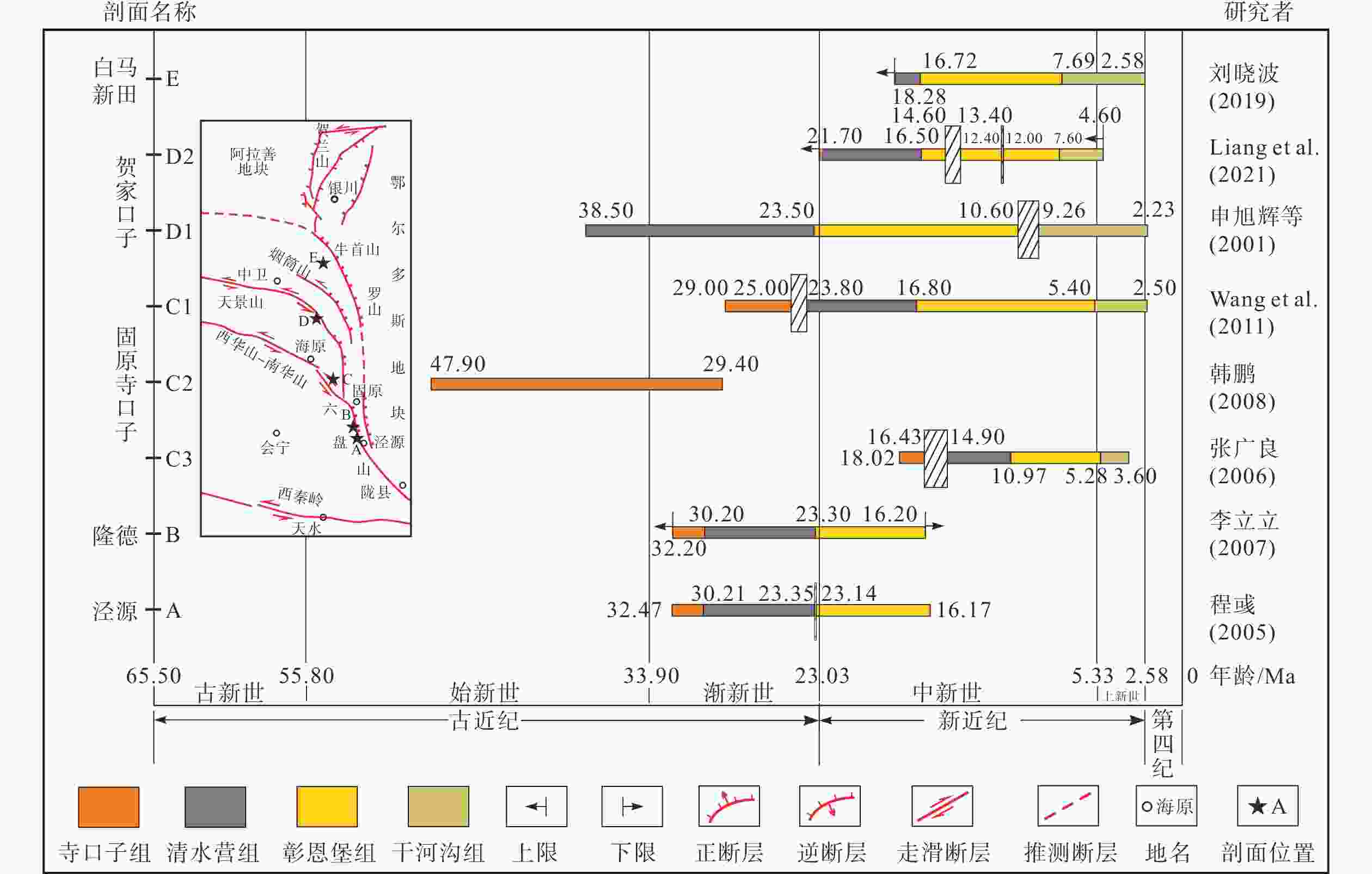Stratigraphic sequence characteristics and geochronology research progress of the Cenozoic in the arcuate tectonic belt on the northeastern margin of the Tibet Plateau
-
摘要:
青藏高原东北缘弧形构造带新生代的构造变形和沉积充填过程既受到了太平洋板块俯冲的远程效应影响,也受到了青藏高原北东向扩展的控制。确定新生代地层的沉积时代是深入理解青藏高原东北缘弧形构造带内构造变形和沉积充填过程的重要前提,但是目前弧形构造带内新生代地层序列和沉积时代仍存在诸多争议。文章系统研究了弧形构造带内古近纪至新近纪沉积序列和地层时代,结果显示弧形构造带内寺口子组、清水营组、彰恩堡组和干河沟组的沉积时代分别为中晚渐新世、晚渐新世—早中新世、中中新世—晚中新世和晚中新世—上新世。综合分析了古近纪至新近纪不整合界面的形成时代,重新厘定了古近纪—新近纪两期不整合及其大地构造意义,第一期不整合发育在清水营组与彰恩堡组之间,时代为早中新世,指示了青藏高原的北东向扩展到达弧形构造带;第二期不整合发育在彰恩堡组与干河沟组之间,时代为晚中新世,指示了青藏高原北东向扩展对弧形构造带的改造达到高峰。讨论了弧形构造带沉积充填过程与构造演化的耦合关系,新生代盆地的沉积演化过程主要经历了三个阶段:自中渐新世至早中新世,弧形构造带主要受控于早期的滨太平洋伸展构造体系域,处于伸展构造背景;早中新世至晚中新世,构造变形和盆地演化开始受到青藏高原北东向扩展的影响,处于挤压构造背景;晚中新世至上新世,弧形构造带持续快速隆升,并且走滑断裂体系的发育分割了新生代盆地。
-
关键词:
- 古近纪—新近纪 /
- 年代学研究 /
- 地层序列 /
- 不整合 /
- 青藏高原东北缘弧形构造带
Abstract:The Cenozoic tectonic deformation and sedimentary processes in the arcuate tectonic belt along the northeastern margin of the Tibetan Plateau have been influenced by the remote effect of the subduction of the Pacific Plate as well as controlled by the northeastward extension of the Tibetan Plateau. Determining the sedimentary age of the Cenozoic strata is an essential prerequisite for understanding these tectonic deformation and sedimentary processes. However, the sequence and depositional age of the Cenozoic strata in the arcuate tectonic belt is still controversial. This paper systematically studied the Paleoproterozoic to Neoproterozoic sedimentary sequences and stratigraphic ages in the arcuate tectonic belt. The results show that the sedimentary ages of the Sikouzi Formation, the Qingshuiying Formation, the Zhang'enbao Formation, and the Ganhegou Formation in the arcuate tectonic belt are the Middle to Late Oligocene, the Late Oligocene–Early Miocene, the Middle Miocene–Late Miocene, and the Late Miocene-Pliocene, respectively. We systematically analyzed the two unconformities of the Paleocene to Neoproterozoic and refined their formation age as well as geotectonic significance. The first unconformity developed between the Qingshuiying Formation and the Zhang'enbao Formation in the Early-Middle Miocene, which indicates the appearance of the remote effect caused by the northeastward extrusion of the Tibet Plateau at about Early Miocene. The second unconformity developed between the Zhang'enbao Formation and the Ganhegou Formation, which implies the summit of tectonic activities caused by the northeastward extrusion of the Tibet Plateau at about the Late Miocene. It is concluded that the Cenozoic basins have evolved through three stages based on the coupling relationship between the sedimentary process and the tectonic evolution. From the Middle Oligocene to the Early Miocene, the tectonic stress field of the arcuate tectonic belt was controlled by extension under the remote effect of the rollback of the subducted Pacific Plate. The tectonic stress field changed into compression under the effect of the northeastward extrusion of the Tibet Plateau from the Middle to Late Miocene; Significant and sustainable tectonic uplift developed in the arcuate tectonic belt from the Late Miocene to Pliocene, and the Cenozoic basins were divided by the strike-slip fault systems.
-
图 2 青藏高原东北缘弧形构造带区域地质简图(据马兆颖等,2020修改)
Figure 2. Simplified geologic map of the arcuate tectonic belt on the northeastern margin of the Tibet Plateau (modified from Ma et al., 2020)
图 4 古近系寺口子组沉积特征
a—观音店剖面中寺口子组中的透镜状含砾粗砂岩;b—观音店剖面中的古近系寺口子组底部的砾岩;c—丁家二沟剖面中寺口子组一段砾岩,含粗砂岩夹层;d—隆德地区观音店剖面中下白垩统乃家河组与古近系寺口子组呈平行不整合接触;e、f—固原地区寺口子剖面中下白垩统乃家河组与古近系寺口子组呈平行不整合接触;g—同心地区丁家二沟剖面下白垩统庙山湖组与古近系寺口子组呈角度不整合接触;h—寺口子剖面中寺口子组底部大型斜层理
Figure 4. Sedimentary characteristics of the Eogene Sikouzi Formation
(a) Lenticular gravelly coarse sandstone of the Eogene Sikouzi Formation in the Guanyindian section; (b) Conglomerates at the bottom of the Eogene Sikouzi Formation in the Guanyindian section; (c) Conglomerates with coarse sandstone interlayers in the first part of the Sikouzi Formation in the Dingjiaergou section; (d) Parallel unconformity between the Early Cretaceous Naijiahe Formation and the Eogene Sikouzi Formation in the Guanyindian section of the Longde area; (e and f) Parallel unconformity between the Early Cretaceous Naijiahe Formation and Eogene Sikouzi Formation in the Sikouzi section of the Guyuan area; (g) Angular unconformity between the Early Cretaceous Miaoshanhu Formation and the Eogene Sikouzi Formation in the Dingjiaergou section of the Tongxin area; (h) Large cross beddings at the bottom of the Eogene Sikouzi Formation in the Sikouzi section
图 5 古近系清水营组沉积特征
a—隆德观音店剖面中古近系清水营组上段砂质泥岩、泥岩与含石膏砂岩互层;b—固原寺口子剖面中古近系寺口子组与清水营组整合接触;c—观音店剖面中古近系清水营组下段石英砂岩与砂质泥岩互层;d—固原寺口子剖面中清水营组顶部砂质泥岩,夹含石膏砂岩层,其中在砂质泥岩顶部发育大量泄水构造;e—寺口子剖面中清水营组顶部砂质泥岩顶部泄水构造;f—同心丁家二沟剖面中古近系清水营组一段石英砂岩与砂质泥岩互层;g—丁家二沟剖面中古近系清水营组二段深灰色石膏层;h—丁家二沟剖面中古近系清水营组三段泥岩和网状石膏脉
Figure 5. Seimentary characteristics of the Eogene Qingshuiying Formation
(a) The interbedded silty mudstone, mudstone and gypseous sandstone in the upper part of the Eogene Qingshuiying Formation in the Guanyindian section of the Longde area; (b) Conformity between the Eogene Sikouzi Formation and the Qingshuiying Formation in the Sikouzi section of the Guyuan area; (c) The interbedded quartz sandstone and silty mudstone in the lower part of the Eogene Qingshuiying Formation in the Guanyindian section; (d) Silty mudstone with gypseous sandstone interlayers at the top of the Eogene Qingshuiying Formation in the Sikouzi section of the Guyuan area, and some water escape structures developed at the top of silty mudstone; (e) Water escape structure developed at the top of silty mudstone of the Eogene Qingshuiying in the Sikouzi section; (f) Interbedded sandstone and silty mudstone in the first part of the Eogene Qingshuiying Formation in the Dingjiaergou section of the Tongxin area; (g) Dark grey gypsum layers in the second part of the Eogene Qingshuiying Formation in the Dingjiaergou section; (h) Mudstone and cancellate gypsum veins in the third part of the Eogene Qingshuiying Formation in the Dingjiaergou section
图 6 新近系彰恩堡组沉积特征
a—观音店剖面中新近系彰恩堡组粉砂质泥岩与粉砂岩互层;b—寺口子剖面中彰恩堡组泥质粉砂岩夹薄层粉砂岩;c—隆德观音店剖面中古近系清水营组与新近系彰恩堡组角度不整合接触;d—寺口子剖面中新近系彰恩堡组与干河沟组平行不整合接触;e—固原寺口子剖面中彰恩堡组泥质粉砂岩与粉砂质泥岩互层;f—同心丁家二沟剖面中新近系彰恩堡组与干河沟组平行不整合接触;g—丁家二沟剖面中彰恩堡组泥质粉砂岩,夹少量薄层泥岩
Figure 6. Seimentary characteristics of the Neogene Zhang'enbao Formation
(a) Interbedded silty mudstone and siltstone in the Zhang'enbao Formation in the Guanyindian section; (b) Argillaceous siltstone with thin siltstone interlayers in the Zhang'enbao Formation in the Sikouzi section; (c) Parallel unconformity between Eogene Qingshuiying Formation and Neogene Zhang'enbao Formation in the Guanyindian section of the Longde area; (d) Parallel unconformity between the Neogene Zhang'enbao Formation and the Ganhegou Formation in the Sikouzi section; (e) Interbedded argillaceous siltstone and silty mudstone in the Zhang'enbao Formation in the Sikouzi section of the Guyuan area; (f) Parallel unconformity between the Neogene Zhang'enbao Formation and the Ganhegou Formation in the Dingjiaergou section of the Tongxin area; (g) Argillaceous siltstone with a few thin mudstone interlayers in the Zhang'enbao Formation in the Dingjiaergou section
图 7 新近系干河沟组沉积特征
a—固原寺口子剖面中干河沟组下部砾岩与粗砂岩互层;b—寺口子剖面中干河沟组上部砾岩与含砾粗砂岩互层;c—寺口子剖面中干河沟组下部砾岩,砾石以泥灰岩砾石为主;d—寺口子剖面中干河沟组上部砾岩,砾石以花岗岩和砂岩砾石为主;e—干河沟组下部砂岩中的斜层理;f—干河沟组底部砂岩中的彰恩堡组泥岩团块;g、h—同心丁家二沟剖面中新近系彰恩堡组与干河沟组平行不整合接触,干河沟组底部发育砂岩
Figure 7. Sedimentary characteristics of the Ganhegou Formation
(a) Interbedded conglomerate and coarse sandstone in the lower part of the Neogene Ganhegou Formation in the Sikouzi section of the Guyuan area; (b) Interbedded conglomerate and pebbly coarse sandstone in the upper part of the Ganhegou Formation in the Sikouzi section; (c) Conglomerate in the lower part of the Ganhegou Formation in the Sikouzi section and the lithology of gravels is mainly marlite; (d) Conglomerate in the upper part of the Ganhegou Formation in the Sikouzi section and the lithology of gravels is mainly granite and sandstone; (e) Cross beddings in the sandstone in the lower part of the Ganhegou Formation; (f) Fragments of the Neogene Zhang'enbao Formation in the sandstone at the bottom of the Ganhegou Formation; (g and h) Parallel unconformity between the Neogene Zhang'enbao Formation and Ganhegou Formation in the Dingjiaergou section of the Tongxin area, and sandstone developed at the bottom of the Ganhegou Formaiton
图 8 青藏高原东北缘弧形构造带新生代地层磁性地层年龄对比图(据刘晓波,2019修改)
A—泾源剖面;B—隆德剖面;C—寺口子剖面;D—贺家口子剖面;E—白马新田剖面
Figure 8. Comparsion of the magnetostratigraphic results of the Cenozoic in the arcuate tectonic belt on the northeastern margin of the Tibet Plateau (modified from Liu, 2019)
A–Jingyuan section; B–Longde section; C–Sikouzi section; D–Hejiakouzi section; E–Baimaxintian section
图 10 青藏高原弧形构造带古近纪—新近纪沉积模式图
a—中晚渐新世寺口子期;b—晚渐新世—早中新世清水营期;c— 中中新世至晚中新世彰恩堡期;d— 晚中新世至上新世干河沟期(寺口子期和干河沟期古水流数据来自野外实测,清水营期和彰恩堡期古水流数据来自Wang et al.,2013)
Figure 10. Sedimentary evolution of the basins in the arcuate tectonic belt on the northeastern margin of the Tibet Plateau during Eogene to Neogene
(a) Middle to late Oligocene Sikouzi period; (b) Late Oligocene to early Miocene Qingshuiying period; (c) Middle to late Miocene Zhang'enbao period; (d) Late Miocene to Pliocene Ganhegou period (Paleocurrents in the Sikouzi and Ganhegou period are measured in the field, and the paleocurrents in the Qingshuiying and Zhangenbao periods are referred from Wang et al., 2013)
-
[1] BURCHFIEL B C, ZHANG P Z, WANG Y P, et al. , 1991. Geology of the Haiyuan fault zone, Ningxia-Hui Autonomous Region, China, and its relation to the evolution of the northeastern margin of the Tibetan Plateau[J]. Tectonics, 10(6): 1091-1110. doi: 10.1029/90TC02685 [2] CHEN H, HU J M, GONG W B, et al. , 2013. Cenozoic deformation and evolution of the Niushou Shan Luo Shan fault zone in the northeast margin of the Tibet Plateau[J]. Earth Science Frontiers, 20(4): 18-35. (in Chinese with English abstract) [3] CHENG Y, 2005. Cenozoic deformation and uplift of the Liupan Shan in the NE Tibetan Plateau: evidence from high-resolution magnetostratigraphy of the foreland basin[D]. Lanzhou: Lanzhou University: 1-110. (in Chinese with English abstract) [4] DING G Y, CHEN J, TIAN Q J, et al. , 2004. Active faults and magnitudes of left-lateral displacement along the northern margin of the Tibetan Plateau[J]. Tectonophysics, 380(3-4): 243-260. doi: 10.1016/j.tecto.2003.09.022 [5] DONG X P, LI Z H, LIU X S, et al. , 2022. Eogene to Neogene north-eastward expansion of the arcuate tectonic belt in north-east Tibetan Plateau: Constraints from detrital zircon geochronology and heavy minerals[J]. Geological Journal, 57(9): 3601-3622. doi: 10.1002/gj.4490 [6] FAN L G, MENG Q R, WU G L, et al. , 2019. Paleogene crustal extension in the eastern segment of the NE Tibetan plateau[J]. Earth and Planetary Science Letters, 514: 62-74. doi: 10.1016/j.jpgl.2019.02.036 [7] FANG J J, 2009. Sedimentary-structural evolution and reformation of Ningnan Basin[D]. Xi’an: Northwest University: 1-103. (in Chinese with English abstract) [8] FANG X M, LIU D L, SONG C H, et al. , 2013. Oligocene slow and Miocene–Quaternary rapid deformation and uplift of the Yumu Shan and North Qilian Shan: evidence from high-resolution magnetostratigraphy and tectonosedimentology[J]. Geological Society, London, Special Publications, 373(1): 149-171. doi: 10.1144/SP373.5 [9] FANG X M, 2017. Phased uplift of the Tibetan Plateau[J]. Science & Technology Review, 35(6): 42-50. (in Chinese with English abstract) [10] Gansu Province Bureau of Geology and Mineral Resources, 1989. Regional geology of Gansu Province[M]. Beijing: Geological Publishing House. (in Chinese) [11] HAN P, 2008. Study on magnetostratigraphy and tectonics of Ningnan basin group[D]. Xi’an: Northwest University: 1-73. (in Chinese with English abstract) [12] HOU L H, ZHOU Z H, ZHANG F C, et al. , 2005. A Miocene ostrich fossil from Gansu Province, northwest China[J]. Chinese Science Bulletin, 50(16): 1808-1810. doi: 10.1360/982005-575 [13] JIANG F Y, JI L Y, ZHAO Q, 2021. Numerical simulation of the present seismic risk of the Haiyuan-Liupanshan fault zone[J]. Journal of Geomechanics, 27(2): 230-240. (in Chinese with English abstract) [14] JIANG H C, DING Z L, XIONG S F, 2007. Magnetostratigraphy of the Neogene Sikouzi section at Guyuan, Ningxia, China[J]. Palaeogeography, Palaeoclimatology, Palaeoecology, 243(1-2): 223-234. doi: 10.1016/j.palaeo.2006.07.016 [15] KOU L L, LI Z H, DONG X P, et al. , 2021. The age sequence of the detrital zircons from the Guanyindian section in Longde, the northeastern margin of the Tibetan Plateau, and its geological significance[J]. Journal of Geomechanics, 27(6): 1051-1064. (in Chinese with English abstract) [16] KOU L L, DONG X P, LI Z H, et al. , 2022. Initiation and development of the Late Cenozoic uplift of Daluo Mountains, northeastern margin of the Tibetan Plateau[J]. Acta Geologica Sinica (English Edition), 96(6): 1917-1931. doi: 10.1111/1755-6724.14891 [17] LEI Q Y, ZHANG P Z, ZHENG W J, et al. , 2016. Dextral strike-slip of Sanguankou-Niushoushan fault zone and extension of arc tectonic belt in the northeastern margin of the Tibet Plateau[J]. Science China Earth Sciences, 59(5): 1025-1040. doi: 10.1007/s11430-016-5272-1 [18] LI J J, FANG X M, PAN B T, et al. , 2001. Late Cenozoic intensive uplift of Qinghai-Xizang Plateau and its impacts on environments in surrounding area[J]. Quaternary Sciences, 21(5): 381-391. (in Chinese with English abstract) [19] LI L L, 2007. Magnetostratigraphy and magnetic susceptibility of Tertiary in the Liupanshan Mountain[D]. Lanzhou: Lanzhou University: 1-109. (in Chinese with English abstract) [20] LI X Z, QU J J, FU T Y, et al. , 2012. Some problems of Sikouzi sandstone in northern Mt. Liupanshan, China[J]. Advances in Earth Science, 27(6): 644-650. (in Chinese with English abstract) [21] LI Y C, QU C Y, SHAN X J, et al. , 2015. Deformation of the Haiyuan-Liupanshan fault zone inferred from the denser GPS observations[J]. Earthquake Science, 28(5): 319-331. [22] LI Y C, SHAN X J, QU C Y, et al. , 2016. Fault locking and slip rate deficit of the Haiyuan-Liupanshan fault zone in the northeastern margin of the Tibetan Plateau[J]. Journal of Geodynamics, 102: 47-57. doi: 10.1016/j.jog.2016.07.005 [23] LI Y H, DU X X, LI T X, 2022. Characterization of the Holocene extensional structures in the Wuwei Basin, northeastern margin of the Tibetan Plateau, and their formation mechanism[J]. Journal of Geomechanics, 28(3): 353-366. (in Chinese with English abstract) [24] LIANG H, ZHANG K, FU J L, et al. , 2021. Sedimentary basin evolution and its implications for outward expansion of the northeastern Tibetan Plateau: Insights from the Tongxin Basin, China[J]. Palaeogeography, Palaeoclimatology, Palaeoecology, 575: 110460. doi: 10.1016/j.palaeo.2021.110460 [25] LIN X B, CHEN H L, WYRWOLL K H, et al. , 2009. Uplift of the northeastern Tibetan Plateau: evidences from the Xiaohonggou section in Tongxin, Ningxia[J]. Acta Geologica Sinica, 83(4): 455-467. (in Chinese with English abstract) [26] LIN X B, CHEN H L, WYRWOLL K H, et al. , 2010. Commencing uplift of the Liupan Shan since 9.5 Ma: Evidences from the Sikouzi section at its east side[J]. Journal of Asian Earth Sciences, 37(4): 350-360. doi: 10.1016/j.jseaes.2009.09.005 [27] LIU X B, 2019. Evolution of the Cenozoic basins in the western margin of the Ordos Block[D]. Beijing: Chinese Academy of Geological Sciences: 1-124. (in Chinese with English abstract) [28] LU H Y, AN Z S, WANG X Y, et al. , 2004. Geomorphic evidence of the latest 14 Ma periodical tectonic uplift of the northeastern Tibetan Plateau[J]. Science in China (Series D): Earth Science, 34(9): 855-864. (in Chinese) [29] MA Z Y, DONG X P, ZHANG Q, et al. , 2020. Sedimentary response to the uplift of the Liupan Shan since the Late Pleistocene and its environmental effects[J]. Coal Geology & Exploration, 48(5): 152-164. (in Chinese with English abstract) [30] Ningxia Hui Autonomous Region Bureau of Geology and Mineral Resources, 1990. Regional geology of Ningxia Hui Autonomous region[M]. Beijing: Geological Publishing House. (in Chinese) [31] QIU Z X, YE J, HUO F C, 1988. Description of a kubanochoerus skull from Tongxin, Ningxia[J]. Vertebrata Palasiatica, 26(1): 1-14. (in Chinese with English abstract) [32] QIU Z X, QIU Z D, 1990. Sequencing and staging of late tertiary local mammals in China[J]. Journal of Stratigraphy, 14(4): 241-260. (in Chinese) [33] SHEN X H, TIAN Q J, DING G Y, et al. , 2001. The late Cenozoic stratigraphic sequence and its implication to tectuic evolution Hejiakouzi area Ningxzia Hui autonomus regin[J]. Earthquake Research in China, 17(2): 156-166. (in Chinese with English abstract) [34] SHI W, ZHANG Y Q, MA Y S, 2006. Elevation distribution pattern of red clay beds in the regions east and west of Liupanshan and Neotectonic significance[J]. Marine Geology & Quaternary Geology, 26(5): 123-130. (in Chinese with English abstract) [35] SHI W, LIU Y, LIU Y, et al. , 2013. Cenozoic evolution of the Haiyuan fault zone in the northeast margin of the Tibetan Plateau[J]. Earth Science Frontiers, 20(4): 1-17. (in Chinese with English abstract) [36] SHI W, HU J M, CHEN H, et al. , 2015. Cenozoic tectonic evolution of the arcuate structures in the Northeast Tibetan Plateau[J]. Acta Geologica Sinica, 89(2): 676-677. doi: 10.1111/1755-6724.12457 [37] SHI W, DONG S W, HU J M, 2020. Neotectonics around the Ordos Block, North China: A review and new insights[J]. Earth-Science Reviews, 200: 102969. doi: 10.1016/j.earscirev.2019.102969 [38] SONG Y G, FANG X M, LI J J, et al. , 2001. The late Cenozoic uplift of the Liupan Shan, China[J]. Science in China Series D: Earth Science, 44(S1): 176-184. doi: 10.1007/BF02911985 [39] WANG W T, ZHANG P Z, ZHANG G L, et al. , 2010. Cenozoic sedimentary evolution of the Sikouzi Basin on the northeastern margin of the Qinghai-Tibetan Plateau and its tectonic significance[J]. Chinese Journal of Geology, 45(2): 440-452. (in Chinese with English abstract) [40] WANG W T, 2011. Sedimentary responses to the Cenozoic tectonic evolution of the northeastern corner of the Tibetan Plateau[D]. Beijing: Institute of Geology, China Earthquake Administrator: 1-145. (in Chinese with English abstract) [41] WANG W T, ZHANG P Z, KIRBY E, et al. , 2011. A revised chronology for Tertiary sedimentation in the Sikouzi basin: Implications for the tectonic evolution of the northeastern corner of the Tibetan Plateau[J]. Tectonophysics, 505(1-4): 100-114. doi: 10.1016/j.tecto.2011.04.006 [42] WANG W T, KIRBY E, ZHANG P Z, et al. , 2013. Tertiary basin evolution along the northeastern margin of the Tibetan Plateau: Evidence for basin formation during Oligocene transtension[J]. GSA Bulletin, 125(3-4): 377-400. doi: 10.1130/B30611.1 [43] WANG W T, ZHENG D W, PANG J Z, 2013. Provenancial tracing for the Cenozoic Sikouzi section in the northeastern margin of the Tibetan Plateau and its tectonic Implications[J]. Acta Geologica Sinica, 87(10): 1551-1569. (in Chinese with English abstract) [44] WANG W T, ZHANG P Z, ZHENG D W, et al. , 2014. Late Cenozoic tectonic deformation of the Haiyuan fault zone in the northeastern margin of the Tibetan Plateau[J]. Earth Science Frontiers, 21(4): 266-274. (in Chinese with English abstract) [45] WANG W T, ZHANG P Z, YU J X, et al. , 2016. Constraints on mountain building in the northeastern Tibet: Detrital zircon records from synorogenic deposits in the Yumen Basin[J]. Scientific Reports, 6(1): 27604. doi: 10.1038/srep27604 [46] YANG F, LI X Z, 2017. Discussion about origin of the Paleogene Sikouzi Formation sandstones in Guyuan, Ningxia[J]. Journal of Palaeogeography, 19(3): 445-456. (in Chinese with English abstract) [47] YAO W Q, 2019. Late Quaternary activity and geometric complexity of the Laohu Shan section and its adjacent area[D]. Beijing: Institute of Geology, China Earthquake Administrator: 1-147. (in Chinese with English abstract) [48] YU X H, MO X X, ZHAO Z D, et al. , 2011. Cenozoic bimodal volcanic rocks of the West Qinling: Implication for the genesis and nature of the rifting of north-south tectonic belt[J]. Acta Petrologica Sinica, 27(7): 2195-2202. (in Chinese with English abstract) [49] ZHANG G L, 2006. An integrated study on Late Cenozoic tectonic deformation in the Liupanshan-Madongshan area, northeastern margin of the Tibetan Plateau[D]. Beijing: Institute of Geology, China Earthquake Administrator: 1-147. (in Chinese with English abstract) [50] ZHANG H P, ZHANG P Z, ZHENG D W, et al. , 2012. Tectonic geomorphology of the Qilian Shan: Insights into the Late Cenozoic landscape evolution and deformation in the north eastern Tibetan Plateau[J]. Quaternary Sciences, 32(5): 907-920. (in Chinese with English abstract) [51] ZHANG J, MA Z J, REN W J, 2005. The Sedimentary characteristics of Cenozoic strata in central and southern Ningxia and their relationships with the development of the Qinghai-Tibetan Plateau[J]. Acta Geologica Sinica, 79(6): 757-773. (in Chinese with English abstract) [52] ZHANG J, MA Z J, REN W J, 2006. Discussion on the tectonic setting of deposition of the Eocene Sikouzi formation in Ningxia region[J]. Geological Review, 52(2): 207-214. (in Chinese with English abstract) [53] ZHANG K, CAI J B, 2006. Preliminary result of the dating by TCN technique of the highest terrace of the Heishanxia gorge mouth, northeast margin of Tibetan Plateau and its expression of neotectonic movement in that area[J]. Quaternary Sciences, 26(1): 85-91. (in Chinese with English abstract) [54] ZHANG P Z, BURCHFIEL B C, MOLNAR P, et al. , 1990. Late Cenozoic tectonic evolution of the Ningxia-Hui Autonomous Region, China[J]. GSA Bulletin, 102(11): 1484-1498. doi: 10.1130/0016-7606(1990)102<1484:LCTEOT>2.3.CO;2 [55] ZHANG P Z, ZHENG D W, YIN G M, et al. , 2006. Discussion on late Cenozoic growth and rise of northeastern margin of the Tibetan Plateau[J]. Quaternary Sciences, 26(1): 5-13. (in Chinese with English abstract) [56] ZHANG Y X, GONG H J, 2003. Taphonomy of Pliocene mammalian fossils from Lingtai, Gansu[J]. Acta Palaeontologica Sinica, 42(3): 460-465. (in Chinese with English abstract) [57] ZHAO Y, 2019. Sedimentary characteristics and tectonic significance of Paleogene-Neogene in Dingjiaergou profile of the southern Ningxia Basin[D]. Beijing: China University of Geosciences (Beijing): 1-93. (in Chinese) [58] ZHENG D W, ZHANG P Z, WAN J L, et al. , 2006. Rapid exhumation at ~8 Ma on the Liupan Shan thrust fault from apatite fission-track thermochronology: Implications for growth of the northeastern Tibetan Plateau margin[J]. Earth and Planetary Science Letters, 248(1-2): 198-208. doi: 10.1016/j.jpgl.2006.05.023 [59] 陈虹, 胡健民, 公王斌, 等, 2013. 青藏高原东北缘牛首山—罗山断裂带新生代构造变形与演化[J]. 地学前缘, 20(4): 18-35. [60] 程彧, 2005. 六盘山山前新生代沉积盆地高精度磁性地层与青藏高原东北边界变形隆升[D]. 兰州: 兰州大学: 1-110. [61] 房建军, 2009. 宁南盆地沉积构造演化与改造[D]. 西安: 西北大学: 1-103. [62] 方小敏, 2017. 青藏高原隆升阶段性[J]. 科技导报, 35(6): 42-50. [63] 甘肃省地质矿产局, 1989. 甘肃省区域地质志[M]. 北京: 地质出版社. [64] 韩鹏, 2008. 宁南盆地群第三系磁学特征及地质构造意义[D]. 西安: 西北大学: 1-73. [65] 侯连海, 周忠和, 张福成, 等, 2005. 甘肃发现中新世鸵鸟化石[J]. 科学通报, 50(12): 1286-1288. [66] 蒋锋云, 季灵运, 赵强, 2021. 海原-六盘山断裂带现今地震危险性的数值模拟分析[J]. 地质力学学报, 27(2): 230-240. [67] 寇琳琳, 李振宏, 董晓朋, 等, 2021. 青藏高原东北缘隆德观音店剖面碎屑锆石年龄序列及地质意义[J]. 地质力学学报, 27(6): 1051-1064. [68] 雷启云, 张培震, 郑文俊, 等, 2016. 青藏高原东北缘三关口-牛首山断裂的右旋走滑与弧形构造带扩展[J]. 中国科学: 地球科学, 46(5): 691-705. [69] 李吉均, 方小敏, 潘保田, 等, 2001. 新生代晚期青藏高原强烈隆起及其对周边环境的影响[J]. 第四纪研究, 21(5): 381-391. [70] 李立立, 2007. 六盘山第三系磁性地层、磁化率及其意义[D]. 兰州: 兰州大学: 1-109. [71] 李孝泽, 屈建军, 傅天阳, 等, 2012. 六盘山北部寺口子砂岩研究现状、问题及意义[J]. 地球科学进展, 27(6): 644-650. [72] 李艺豪, 杜星星, 李天秀, 2022. 青藏高原东北缘武威盆地内部全新世伸展构造特征及其成因机制[J]. 地质力学学报, 28(3): 353-366. [73] 林秀斌, 陈汉林, WYRWOLL K H, 等, 2009. 青藏高原东北部隆升: 来自宁夏同心小洪沟剖面的证据[J]. 地质学报, 83(4): 455-467. [74] 刘晓波, 2019. 鄂尔多斯地块西缘新生代盆地演化[D]. 北京: 中国地质科学院: 1-124. [75] 鹿化煜, 安芷生, 王晓勇, 等, 2004. 最近14 Ma青藏高原东北缘阶段性隆升的地貌证据[J]. 中国科学(D辑): 地球科学, 34(9): 855-864. [76] 马兆颖, 董晓朋, 张庆, 等, 2020. 六盘山晚更新世以来抬升过程沉积响应及环境效应[J]. 煤田地质与勘探, 48(5): 152-164. [77] 宁夏回族自治区地质矿产局, 1990. 宁夏回族自治区区域地质志[M]. 北京: 地质出版社. [78] 邱占祥, 叶捷, 霍福臣, 1988. 记宁夏同心发现的库班猪头骨化石[J]. 古脊椎动物学报, 26(1): 1-14. [79] 邱占祥, 邱铸鼎, 1990. 中国晚第三纪地方哺乳动物群的排序及其分期[J]. 地层学杂志, 14(4): 241-260. [80] 申旭辉, 田勤俭, 丁国瑜, 等, 2001. 宁夏贺家口子地区晚新生代地层序列及其构造意义[J]. 中国地震, 17(2): 156-166. [81] 施炜, 张岳桥, 马寅生, 2006. 六盘山两侧晚新生代红黏土高程分布及其新构造意义[J]. 海洋地质与第四纪地质, 26(5): 123-130. [82] 施炜, 刘源, 刘洋, 等, 2013. 青藏高原东北缘海原断裂带新生代构造演化[J]. 地学前缘, 20(4): 1-17. [83] 宋友桂, 方小敏, 李吉均, 等, 2001. 晚新生代六盘山隆升过程初探[J]. 中国科学(D辑): 地球科学, 31(S1): 142-148. [84] 王伟涛, 张培震, 张广良, 等, 2010. 青藏高原东北缘寺口子盆地新生代沉积演化及其构造意义[J]. 地质科学, 45(2): 440-452. [85] 王伟涛, 2011. 宁夏南部新生代盆地沉积演化及其对青藏高原东北角构造变形的响应[D]. 北京: 中国地震局地质研究所: 1-145. [86] 王伟涛, 郑德文, 庞建章, 2013. 青藏高原东北缘寺口子剖面碎屑锆石示踪及其构造意义[J]. 地质学报, 87(10): 1551-1569. [87] 王伟涛, 张培震, 郑德文, 等, 2014. 青藏高原东北缘海原断裂带晚新生代构造变形[J]. 地学前缘, 21(4): 266-274. [88] 杨帆, 李孝泽, 2017. 宁夏固原古近系寺口子组砂岩成因探讨[J]. 古地理学报, 19(3): 445-456. [89] 姚文倩, 2019. 海原断裂老虎山段及其邻区晚第四纪活动性及几何复杂度研究[D]. 北京: 中国地震局地质研究所: 1-147. [90] 喻学惠, 莫宣学, 赵志丹, 等, 2011. 西秦岭新生代双峰式火山作用及南北构造带成因初探[J]. 岩石学报, 27(7): 2195-2202. [91] 张广良, 2006. 青藏高原东北缘六盘山—马东山地区晚新生代构造变形综合研究[D]. 北京: 中国地震局地质研究所: 1-147. [92] 张会平, 张培震, 郑德文, 等, 2012. 祁连山构造地貌特征: 青藏高原东北缘晚新生代构造变形和地貌演化过程的启示[J]. 第四纪研究, 32(5): 907-920. [93] 张进, 马宗晋, 任文军, 2005. 宁夏中南部新生界沉积特征及其与青藏高原演化的关系[J]. 地质学报, 79(6): 757-773. [94] 张进, 马宗晋, 任文军, 2006. 试论宁夏地区始新统寺口子组沉积的构造背景[J]. 地质论评, 52(2): 207-214. [95] 张珂, 蔡剑波, 2006. 黄河黑山峡口最高阶地宇宙核素的初步年龄及所反映的新构造运动[J]. 第四纪研究, 26(1): 85-91. [96] 张培震, 郑德文, 尹功明, 等, 2006. 有关青藏高原东北缘晚新生代扩展与隆升的讨论[J]. 第四纪研究, 26(1): 5-13. [97] 张云翔, 弓虎军, 2003. 甘肃灵台上新世哺乳动物化石埋藏学[J]. 古生物学报, 42(3): 460-465. [98] 赵杨, 2019. 宁南盆地丁家二沟剖面古近纪—新近纪沉积特征及其构造意义[D]. 北京: 中国地质大学(北京): 1-93. -





 下载:
下载:

